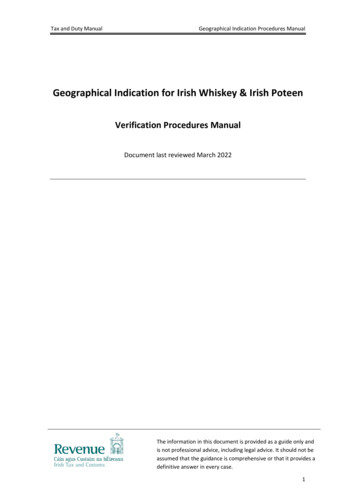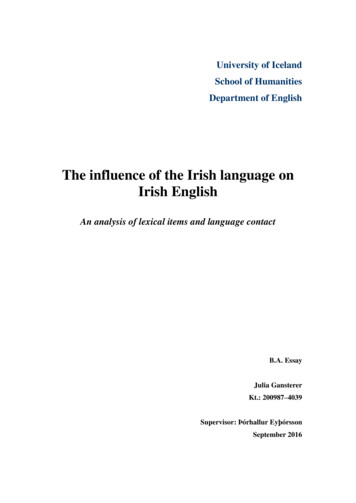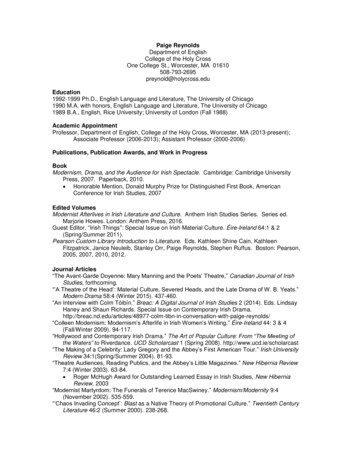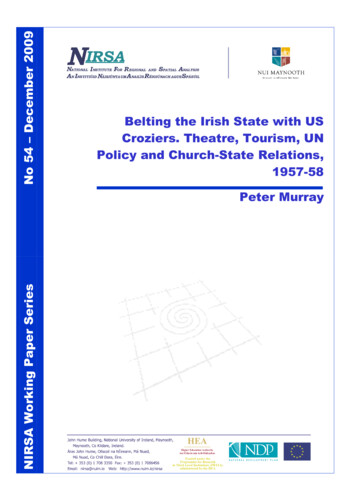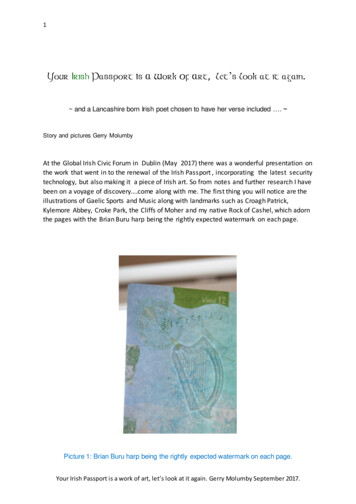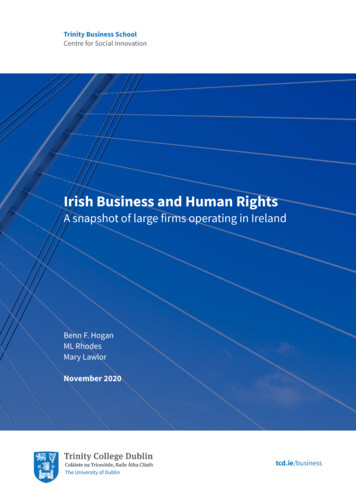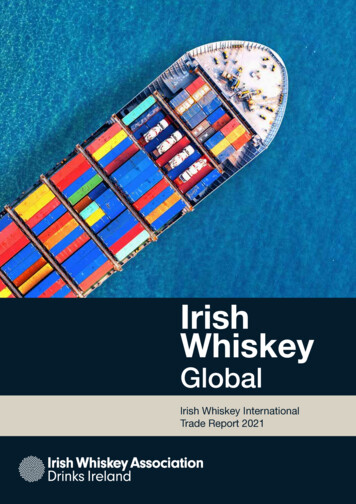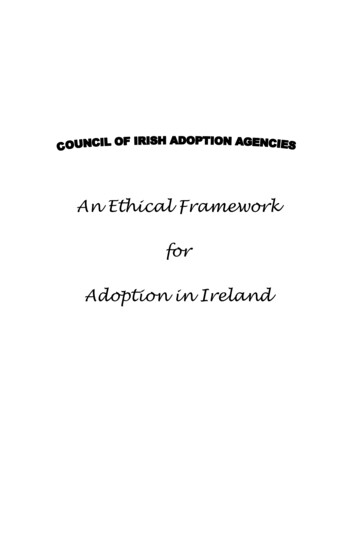
Transcription
An Ethical FrameworkforAdoption in Ireland
2009 Council of Irish Adoption AgenciesAll rights reserved. No part of this publication may be reproduced inany form or by any means – graphic, electronic, or mechanical,including photocopying, recording, taping or information storage andretrieval systems – without the prior written permission of the author.ISBN: 978-1-907107-06-1A CIP catalogue for this book is available from the National Library.This book was published in cooperation withChoice Publishing & Book Services Ltd, Drogheda, Co Louth, IrelandTel: 041 9841551 Email: info@choicepublishing.iewww.choicepublishing.ie
The Council of Irish Adoption Agencies is the umbrellabody incorporating all adoption agencies, both voluntaryand statutory, in the Republic of Ireland. Council membersmeet a number of times each year to consider, address andadvocate on the basis of ‘best practice’, all aspects ofadoption. While it is the agencies themselves who aremembers of the CIAA, it is the professionals directlyinvolved in the day-to-day operation of the adoptionservices, namely social workers, who usually representeach agency at Council.Council members believe that adoption practitioners ingeneral, and the Council of Irish Adoption Agencies inparticular, are uniquely placed to advise on all areas ofadoption as, through our work, we have access to theperspective of each member of the “adoption triad”,namely the child, birth/natural parent/s and adoptiveparent/s. Our training and experience give us furtherinsights into the needs of children in foster care, childrenwhose lives are impacted by the breakdown of parentalrelationships, the needs of blended families and the rightsto protection for children under Children First (1999).In considering an Ethical Framework, Council membersselected a sub-group to draw together a document relyingon international best practice and considering adoptionissues within an Irish context. In recognition of theexperience, expertise and commitment to excellence of thesocial work team at the Adoption Board, Council alsoinvited onto this sub-group Ms Emer O’Carroll, SocialWorker, Adoption Board. The Ethical Framework set outhere, therefore, represents collaboration of adoption socialwork across a wide perspective of voluntary and statutoryagencies and social work practice at the Adoption Board.
The CIAA wishes to thank the following members of theEthics Sub-Group for their commitment and expertise incompiling this document:Seamus O’GallchoirSt. Mura’s Adoption AgencyEmer O’CarrollAdoption BoardAngela LoaneHealth Service Executive,Dublin Mid-LeinsterAlison SaundersCunamh Adoption AgencyEilish CraigHealth Service Executive,Dublin North EastMarian BennettHealth Service Executive,Dublin Mid-LeinsterAngela Loane resigned from the Subcommittee in March2006 due to a career change.
For children who, for whatever reason, cannot be rearedby their birth families “adoption provides the strongestlegal guarantee of permanence . For those childrenwho cannot be raised by their birth parents, adoption isthe permanency option most likely to ensure shipsthroughout their childhood as well as into theiradulthood. Individuals do not outgrow their need for therelationships and the support offered through familyties” (Child Welfare League of America, 2000, p11)
Table of ContentsPart OneWhat is Adoption?. .The Purpose of Adoption .What are Ethics? . .Why an Ethical Framework? . .Ethics in Adoption .The Role of Adoption Agencies Professional Adoption Social Work Values .Page1123345Part TwoHistorical Context of Irish Adoption .Current Trends in Irish Adoption .Ethical Dilemmas in Irish Adoption .Bunreacht na hEireann and Adoption Practice 891117Part ThreeCore Values in Adoption Practice in Ireland .An Ethical Framework for Adoption in Ireland 2628Conclusion .49Bibliography .50
PART ONEWhat is Adoption?The Adoption Act, (1952), introduced legal adoption intoIreland for the first time. The legislation set out that, on themaking of an adoption order (a) “the child shall beconsidered with regard to the rights and duties of parentsand children in relation to each other as the child of theadopter or adopters born to him, her or them in lawfulwedlock”; (b) “the mother or guardian shall lose allparental rights and be freed from all parental duties withrespect to the child” (Adoption Act 1952, Section 24).Therefore, the nature and effect of an Irish adoption orderis that a child becomes the child of the adopters as if bornto them in marriage.Since 1952 the practice of adoption has undergone manychanges in Ireland and it is now widely accepted thatadoption is much more than a simple legal procedure.Many definitions of adoption appear in the literature(Practice Guidelines for Domestic Adoption Assessment inIreland, 2006, p12-13, unpublished). However, thedefinition underpinning this CIAA document is that putforward by the International Social Services who defineadoption as “a social and legal protective measure forchildren” which “should be made available to all childrenwhose personal and family situation warrants withoutprejudice against their social situation, physical features,ethnicity, culture, physical or mental health disorder.”(International Social Service, 1999 – 2004, p3)The Purpose of AdoptionThe Association of Directors of Social Services in “What isAdoption?” (ADSS-BAFF, 2000) states that “the primary1
purpose of adoption is to provide a child with a family anda home to call his/her own and not to provide a child for afamily”. This publication goes on to consider that, whilethere are many complementary and conflicting needs andrights in adoption, children must remain central, as theyare the most vulnerable and often the voiceless party to anadoption. “Meeting the needs of children is central toadoption”. (ADSS-BAAF, 2000). The ADSS further statesthat adoption seeks to provide children with anopportunity of “having a happy secure and stable familylife” and of “growing up physically, legally, spirituallyand emotionally in a secure home”. It specifically cautionsagainst adoptionbecoming a means of “removingchildren from being a costly burden on the state”,“warehousing children who are otherwise a nuisance” or“satisfying individuals’ or couples’ needs to have childrenregardless of children’s needs.” (ADSS-BAAF, 2000).What are Ethics?“Although definitions vary, most people agree that ethicsnecessarily involves articulation of values that can guidethe decision-making process around complex issues”(Freunlich and Phillips, 2000, p7).Ethics is further defined as “the study of fundamentalprinciples that defines values and determines moral dutyand Glossary 1-2001.htm);and with regard to professionals (as, for example, thesocial work profession) ethics provides “a code ofprofessional standards, containing aspects of fairness andduty to the profession and the general public”.(www.titleguarantynm.com/terms e.asp).2
As the foregoing definitions set out, professionals set outvalues and codes of behaviour and standards in meetingtheir responsibilities both to the public (service users) andto the profession itself.Why an Ethical Framework?In drawing together an ethical framework it is recognisedthat “an ethical framework can help make explicit thequestion of what ought to be done in any situation, allthings considered; and promotes a decision-makingprocess that is as impartial, rational, thorough and realisticas possible” (Abramson, 1990, p30). Significant words andphrases here are that an ethical framework seeks to makeclear what ought to be done in any situation and that itseeks to make the process as impartial, rational aspossible.Ethics in AdoptionAdoption practice requires that adoption professionalsdefine values and determine their moral duty andobligations towards all members of the adoption circlecomprising the adopted person, the birth/natural families,adoptive families, adoption agencies and the State.“Creating an ethical climate for adoption is importantgiven the fact that so much of the personal impact ofadoption is beyond the reach of law, regulation and policy.Ethics always lies outside of law and policy, informing it,challenging it, and coming into play when new situationsare encountered. It is never easy for law to regulate rightbehaviour and in the area of adoption it will never get itentirely right” (Jordan, 2000, p1). The foregoing recognisesthat, due to the possibility of conflicting needs and rights,the best we can hope to achieve is the balancing of rights3
and needs and the setting of one set of needs (those of theadopted child) as paramount.Thus, as a core principle, this Ethical Framework endorsesthe following:“Any assessment of value issues in adoption must bemade in the context of the only reason for the institution ofadoption to exist: providing for the healthy rearing ofchildren” (Dukette, 1984, p241).The Role of Adoption AgenciesInternational Social Services, (ISS, 1999-2004), recommendsthe following: that in order to ensure international bestpractice, bodies or persons who play a role in adoptionprocedures, whatever the importance or level of theirparticipation, comprise agencies whose staff is composedof pluridisciplinary professionals in child protection (socialworkers, psychologists, jurists), who have benefited fromspecial training in adoption and the rights of the child andwho are guided by ethical standards in the best interests ofthe child. ISS further states that experience as an adoptiveparent is not a sufficient qualification to play a role inadoption procedures (placements). Moreover, whileacknowledging the indisputable value of volunteer work,ISS considers that it cannot be recognised as a skill in itself,and does not justify overlooking professionalqualifications in child protection and welfare.Other core values relating to the provision of services statethat changes in adoption practice, policy and law demandprofessional expertise to assist birth/natural families,adoptive families and adopted individuals and that theknowledge, skill and experience of professional socialworkers should be used in developing and providing all4
aspects of adoption services (CWLA, 2000). This latterpublication goes on to state “because adoption is aspecialised professional service, the agency providingadoption services should rely upon and use theknowledge, skill and experience of professional socialworkers in delivering and providing all aspects of suchservices”. Part of the social work function involves“help(ing) all parties concerned to understand and addressthe issues confronting them when the adoption is legalisedand thereafter” (CWLA, 2000).Professional Adoption Social Work ValuesIn Ireland, adoption practice, for the most part, comprisesprofessionally qualified and experienced social workers.Social work, as a profession, recognises the importance of,and is guided by, the code of ethics of the Irish Associationof Social Work (I.A.S.W.). “Ethical awareness is anecessary part of the professional practice of any socialworker. His or her ability to act ethically is an essentialaspect of the quality of the service offered to clients”(I.F.S.W. The New Ethical Documents, 2004, p1).In the Irish context, social workers affiliated to theprofessional body of the Irish Association of SocialWorkers agree to maintain and promote the IrishAssociation of Social Workers Code of Ethics (see Code ofPractice for members of the Irish Association of SocialWorkers’ Members at www.iasw.ie)Social Work is committed to the promotion of bestadoption practice. “Good practice must spring fromevidence, the use of the latest research and a constant focuson how best to meet the needs of individual children”(ADSS-BAAF, 2000).5
Irish adoption practice holds as fundamental the followingvalues:Confidentiality The assurance that private information will bemade available only to those third parties whohave a right to the information or to individualswhose professional involvement warrants access tothe information.Fairness The assurance that objectivity will be maintainedand bias avoided.Equity The assurance that equality of opportunity will beprovided to those availing of the service.Accountability The assurance that professionals will acceptresponsibility for outcomes from practice andaction taken.Respect A commitment to protecting the inherent worthand dignity of each individual and promoting thisperspective in those availing of the service.6
Autonomy A commitment to enabling informed and freedecisions; this value is also referred to as Client SelfDetermination.Knowledge A commitment to providing clear, value-freeinformation and updating such information whenappropriate; ensuring that each person has therelevant information to enable him/her to make aninformed decision.Beneficence A commitment to act for the good or well being ofthe individual.7
PART TWOHistorical Context of Irish AdoptionLegal adoption was introduced in England and Wales in1926, Northern Ireland in 1929, and Scotland in 1930.“Pressure for legal adoption did not, however, start tobuild up in Ireland until the late 1930’s and did notbecome urgent until the second half of the 1940’s and,perhaps, then because of the increase in the illegitimacyrate” (Darling, 1977, p6). The Adoption Society (Ireland)was formed in 1948 as a pressure group for theintroduction of legal adoption. “Yet despite its scratchnature, it proved an uncommonly effective pressuregroup” (Whyte, 1980, p185). However, there wasconsiderable resistance towards any form of legaladoption. There was a fear that parents would simply giveaway or abandon their children, or that they would havechildren simply to sell them (Shatter, 1997, p445). “It wasthe strong feeling, especially in the Irish countryside, thatproperty should go to someone of one’s own blood”(Whyte, 1980, p187). “It has been suggested that fear ofproselytisation was probably the strongest objection tolegal adoption” (O’Hare et al, 1983, p13).The Archbishop of Dublin, Dr. McQuaid, initially opposedthe introduction of adoption legislation. He was notopposed to the concept of legal adoption as such, but wasconcerned for the protection of the rights of the motherand child. He felt too much emphasis was being placed onthe rights of the adoptive couple (Whyte, 1980, p192). TheCatholic Church was consulted closely about thelegislation “and the text of the bill bore out the closeness ofthe consultation, for regard was had to all the limits andsafeguards for which the committee of the hierarchy hadasked” (Whyte, 1980, p276).8
Any discussion on ethics in adoption in Ireland must beunderstood not only in the historical and political contextof the time, as outlined above, but also in the social climatethat prevailed when legal adoption was first introduced.The 1950s was a decade characterised by poverty,unemployment and massive emigration. The prevailingmoral code of the time dictated that no family form wasacceptable other than the traditional nuclear family basedon marriage, as enshrined in the Constitution andpropagated by the Roman Catholic Church. The passing ofthe 1952 Adoption Act allowed for non-marital childrenonly to be adopted by legally married, heterosexualcouples. This bestowed the status of ‘legitimacy’ on theadopted child, serving as a mechanism for removing thestigma of non-marital birth from the child, while alsosatisfying the parenting needs of couples.Current Trends in Irish Adoption (Source: adapted fromthe Practice Guidelines for Domestic Adoption Assessmentin Ireland, 2006 P13-14, unpublished)Since legal adoption was introduced in Ireland, over 43,000adoption orders have been granted. The number of ordersgranted peaked in 1967 to 1,493, a figure which accountedfor 96.9% of non-marital births that year. By 2007 thisfigure had dropped to 187 adoption orders, accounting for0.81% on non-marital births (Report of An Bord Uchtala,2007, p41). Within this period the profile of adoption inIreland changed immensely. This change is characterisedby; The decline in the total number of adoption ordersgranted.The decline in traditional infant agency adoption.9
The move from a closed to a more open form ofadoption involving ongoing contact between thebirth/natural and the adoptive familyAn increase in family adoptions, particularly stepparent adoptions.The introduction of the Adoption Act, 1988 whichallows for the adoption of marital children withoutbirth/natural parents’ consent.The Adoption Act, 1998 which makes provision forthe consultation of birth/natural fathers inadoption applications.A demand for the further development of socialwork and mediation services to birth/naturalfathers.A significant increase in the rate of Inter-CountryAdoption.The introduction of the Adoption Act, 1991.An upsurge in the number of Information andTracing queries countrywide.An ever increasing demand for Post AdoptionServices.The establishment of both the National AdoptionContact Preference Register, 2005 and theStandardised Framework for the Provision of aNational Information and Tracing Service, 2007.Despite these changes, some of the traditionalcharacteristics of Irish adoption remain, for exampleconcealed pregnancies, secrecy and stigma (O’Carroll,2002). Indeed, there is evidence to suggest that adoption,as it is traditionally framed in Ireland, facilitates theretention of these characteristics (Mahon et al, 1998,O’Carroll, 2002, Loughran and Richardson, 2005). Newcharacteristics also emerge in contemporary adoptionincluding various blended family arrangements andincreased complexities around individual cases (Loftus,10
2004); for example, the increased involvement ofbirth/natural fathers with their children and in theadoption process. These new characteristics can beattributed to the great social and economic changes inIreland in recent times.Thus, there is a recognition among adoption practitionersof a need to reframe adoption as a modern child careoption in a creative way to meet the needs of modern Irishsociety and the changing profile of children requiringpermanent care (Doherty, 1990, p13, O’Carroll 2002, p88,Loughran and Richardson 2005, p17). (Source: adaptedfrom the Practice Guidelines for Domestic AdoptionAssessment in Ireland, 2006 P13-14, unpublished)Ethical Dilemmas in Irish AdoptionDebate regarding adoption often focuses on the issue ofrights: the rights of the child, the rights of thebirth/natural parents, the rights of the adoptive parents. Itmust be acknowledged that these rights and needs are notcomplementary and, in fact, can often be in conflict.Balancing rights and needs is an ongoing ethical issue inadoption.A fundamental social work principle in adoption practiceseeks to hold the best interests of the child at the centre ofall considerations. However, should this ‘paramountcyprinciple’ take into account the entire life of the adoptedperson or the child’s needs at the time of the adoptiononly? This is just one of many ethical dilemmas facingadoption social workers.In considering the social work values as set out on pages 6and 7, other challenges and dilemmas which routinelypresent themselves in adoption practice are as follows:11
Confidentiality Total confidentiality, meaning privacy or secrecy, isnever guaranteed in social work. Safe workingpractices, alone, require that information regardingthe client is shared with at least one ion on the social worker’s practice. Anongoingchallengefacingadoptionprofessionals and, in particular those working inthe area of Adoption Information and Tracing,relates to confidentiality and promises of secrecy inthe past. Practice up until the late 1980’s saw manybirth/natural mothers given guarantees of secrecyin order to make a ‘fresh start’ after placing theirchildren for adoption. These promises left manybirth/natural mothers with a sense of protection.However, for their children, this guarantee hasbecome a barrier to information they have a deeplyfelt need for and to which they believe they have aright. The dilemma facing adoption social workers is oneof balancing the need for privacy for one memberof the adoption circle with the need for opennessand information for another member of the circle;whose need takes precedence?Fairness The question needs to be asked, are we ever totallyfree of bias? Adoption is a highly emotive subject,drawing on strong views among members of thepublic and some members of the social workprofession alike. Among some professionals thereexists a bias against adoption, as repeatedlyindicated in the research (Richardson andLoughran, 2005, Richardson 1993, McCashin 1996,O’Donohue 1990).12
Equity Ensuring equality of opportunity to all thoseseeking adoption services can be challenging,especially given the perception among someservice users and some professionals that ‘theloudest voice prevails’. How can adoption workersensure that those without a voice, especially thechild at the centre of the process, are given equalityof opportunity? Kelly (2005) and Richardson and Loughrane (2005)found that social conditions, including poverty andsocial stigma, continue to influence the decision toplace a child for adoption. These studies cite thereality that some birth/natural parents continue toplace their children for adoption out of a sense ofhaving no other option open to them. How cansocial workers advocate for families in a way thatensures equality of opportunity, so that parents donot feel they have no option open to them otherthan adoption? As a profession, social work stands accused offacilitating the movement, through adoption, ofchildren from poor/disadvantaged communities toricher/more socially advantaged communitieswithout sufficiently challenging the conditionswhereby parents are obliged to relinquish theirchildren (Vass, 1996). Social workers are challengedto address this issue while simultaneously holdingand supporting the needs of individual adoptivefamilies. There is growing concern among adoptionpractitioners in Ireland and overseas (Evan BDonaldson Institute, 1999), regarding intercountryadoption in terms of adoption ethics, market forces(Freundlich & Phillips, 2000) and an apparentlygrowing consumer-driven culture in adoption13
practice (Triseliotis et al, 1997). Social workersstruggle with these ethical issues in a countrywhich gives a statutory right to assessment forintercountry adoption to any individual aged 21years and upwards (or, if a married couple, one ofthe applicants is aged 21 years and upwards) in thisState. This statutory right to a service impactsdirectly on the provision of services to otheradoption service users and impacts directly thevalue of equity.Accountability Some past practices in adoption services fell shortof the value of accountability. Ensuring that currentand future practice meets the highest standardsrequires continuous scrutiny and review. Given thedemands on overstretched services, this may not beas straightforward as it appears. To whom are adoption workers accountable; theagency, the professional organisation, the AdoptionBoard, the courts, the child, birth/natural parents,adoptive parents? At what venue are these issueseven debated?Respect While recognising the need to respect the wish forprivacy of birth/natural and prospective adoptiveparents, social workers strive constantly to balancethis value with the need for relevant information;the information sought assists in the matching andplacement for adoption of a child.Autonomy Client self-determination poses challenges at manylevels in adoption.14
The birth/natural parents’ wish to defer decisionmaking may be in conflict with the child’s need fora permanent home. Babies are particularlyvulnerable with regard to timing around decisionmaking in the first year of life. In 2007, only 32% ofbabies placed for domestic adoption were under 6months old (Adoption Board Annual Report 2007,p35).Legal restrictions and adoption practice limit theprospective adopter’s wish to become a parentwithout the necessity of professional assessment.Further legal restrictions apply when the adoptedperson seeks identifying information regardinghis/her biological background.When seeking to enable informed and freedecisions, social workers work within theserestrictions and recognise that client autonomy islimited.Knowledge Crucial issues in relation to this value begin withthe importance of informing the birth/naturalparents about the impact of adoption in a timelyfashion, thus enabling them to consider the optionswithout undue pressure. This value may be inconflict with the child’s need for timely decisions(Kelly, 2005). This core value creates additional challenges forsocial workers providing an intercountry adoptionservice, as anecdotal evidence and a growingamount of international literature suggest thatthere is some doubt over birth/natural parentsbeing facilitated in making informed decisionsregarding adoption in some placing countries. Providing balanced information to prospectiveadoptive parents so that they can appreciate both15
the rewards and challenges in adoption isimportant. Given the paucity of reliable research inintercountry adoption, especially in relation topractice in some sending countries, social workersare challenged when trying to meet thisresponsibility especially when relying on anecdotalevidence that itself may not be balanced.When the birth/natural parent relinquishes a child,is the child's right to know who they are and whattheir background is, also relinquished? Manyadopted people need to know about their origins inorder to have a complete sense of themselves andto feel connected to the world both genetically andenvironmentally. Should adopted people have thelegal right to access all information aboutthemselves? Can they be harmed by their exclusionfrom information about their origins and early life?Beneficence Seeking to act for the good of one individual in theadoption process may risk causing harm to anotherperson.For example Attempting to balance the birth/natural parents’needs and rights may not be complementary to thechild’s need of and right to a permanent home. Similarly, seeking to act for the good of the adoptedperson’s need for information may risk harm to thebirth/natural parent who has a continued need forsecrecy. In adoptive parent assessment there is a need toensure that, in meeting the adult’s need for a child,the focus remains on the child’s need for a safe,secure and loving family.16
In considering current dilemmas facing adoption socialworkers, there is a need also to reflect on the reality thatprevailing cultural attitudes towards adoption changewith time and that these attitudes impact on everymember of the circle. A significant issue surrounds privacyand the need for secrecy. For example, in 1950s Ireland,birth/natural mothers needed the secrecy of the adoptionto be maintained due to the social stigma of out of wedlockpregnancy. In modern Ireland, a significant proportion ofwomen availing of adoption services express a need forsecrecy due to what they perceive as the stigma attached toplacing their child for adoption (Kelly (2005), O’Carroll,(2002).There is also the need to take into consideration the impactof the constitutional context in Ireland and its protection ofthe family. While it protects individual families, TheConstitution does not give recognition to the overlap anadopted person has between different nuclear families,genetically, biologically, psychologically and historically.What are social workers’ responsibilities when the law andethics are in conflict? Further consideration of theimplications for practice arising out of the Constitution isset out below.Bunreacht na hEireann (1937) and Adoption Practice inIrelandAll current childcare and adoption legislation, andconsequently practice, in Ireland is informed by theConstitution. In 2005, the Council of Irish AdoptionAgencies, in its submission to the All Party OireachtasCommittee on the Constitution (The Family Module),considered the following issues as important to adoptionpractice:17
‘The Kilkenny Incest Investigation (1993) noted that thereis a perception of over-emphasis on the constitutionalrights of the family that, in practice, is interpreted as therights of parents. Furthermore, the unique constitutionalposition of the family based on marriage impacts onfamilies at many levels, and the results of all of the abovecan be seen in adoption practice in the following areas:a) Adoption consent - although section 3 of theAdoption Act, 1974 states that the welfare of thechild is to be “the first and paramountconsideration”, the perception among adoptionpractitioners is that the rights of the mother towithdraw consent carries greater weight by virtueof our Constitution. “The ‘paramountcy’ test onlycomes under consideration when the motherhad voluntarily and freely placed the child foradoption. The revered nature of the mother andchild relationship, under the Constitution, and thenature of adoption . require that the process beentered into voluntarily” (Shannon, 2004).Over the past number of years, concern has beenexpressed both by adoption practitioners and bythe Adoption Board (Report of An Bord Uchtala,2003) regarding the sometimes lengthy delays inplacing children for adoption under the terms ofthe Adoption Acts, 1952 – 1998. These delays,practitioners believe, are due to what appears to beincreasingly stringent requirements relating to theconsent to place for adoption and to theconsultation of birth/natural fathers. Whileadoption practitioners are committed to facilitatingparents
The Council of Irish Adoption Agencies is the umbrella body incorporating all adoption agencies, both voluntary and statutory, in the Republic of Ireland. Council members meet a number of times each year to consider, address and advocate on the basis of 'best practice', all aspects of adoption. While it is the agencies themselves who are
